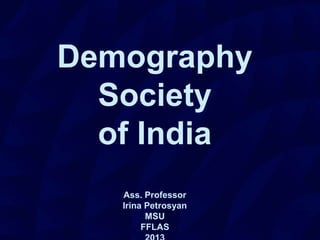India: Demography and Society
•Als PPT, PDF herunterladen•
2 gefällt mir•1,133 views
Melden
Teilen
Melden
Teilen

Empfohlen
Weitere ähnliche Inhalte
Was ist angesagt?
Was ist angesagt? (20)
Population growth and economic development in india

Population growth and economic development in india
Chapter - 6, Population, Geography, Social Science, Class 9

Chapter - 6, Population, Geography, Social Science, Class 9
Ähnlich wie India: Demography and Society
Ähnlich wie India: Demography and Society (20)
Asur community peoples' attitude towards education

Asur community peoples' attitude towards education
Government Policy, Schemes, Law for Senior Citizens in India 

Government Policy, Schemes, Law for Senior Citizens in India
Demography, population explosion n demographic trends

Demography, population explosion n demographic trends
World population day and migration july 11, 2018 lakshmikutty

World population day and migration july 11, 2018 lakshmikutty
presentation_population_ppt_1527316824_147767.pptx

presentation_population_ppt_1527316824_147767.pptx
Kürzlich hochgeladen
God is a creative God Gen 1:1. All that He created was “good”, could also be translated “beautiful”. God created man in His own image Gen 1:27. Maths helps us discover the beauty that God has created in His world and, in turn, create beautiful designs to serve and enrich the lives of others.
Explore beautiful and ugly buildings. Mathematics helps us create beautiful d...

Explore beautiful and ugly buildings. Mathematics helps us create beautiful d...christianmathematics
Kürzlich hochgeladen (20)
Measures of Dispersion and Variability: Range, QD, AD and SD

Measures of Dispersion and Variability: Range, QD, AD and SD
Micro-Scholarship, What it is, How can it help me.pdf

Micro-Scholarship, What it is, How can it help me.pdf
Energy Resources. ( B. Pharmacy, 1st Year, Sem-II) Natural Resources

Energy Resources. ( B. Pharmacy, 1st Year, Sem-II) Natural Resources
Unit-V; Pricing (Pharma Marketing Management).pptx

Unit-V; Pricing (Pharma Marketing Management).pptx
Unit-IV; Professional Sales Representative (PSR).pptx

Unit-IV; Professional Sales Representative (PSR).pptx
Asian American Pacific Islander Month DDSD 2024.pptx

Asian American Pacific Islander Month DDSD 2024.pptx
Measures of Central Tendency: Mean, Median and Mode

Measures of Central Tendency: Mean, Median and Mode
Explore beautiful and ugly buildings. Mathematics helps us create beautiful d...

Explore beautiful and ugly buildings. Mathematics helps us create beautiful d...
Ecological Succession. ( ECOSYSTEM, B. Pharmacy, 1st Year, Sem-II, Environmen...

Ecological Succession. ( ECOSYSTEM, B. Pharmacy, 1st Year, Sem-II, Environmen...
India: Demography and Society
- 1. Demography Society of India Ass. Professor Irina Petrosyan MSU FFLAS
- 2. Demographics: introduction http://ngm.nationalgeographic.com/7-billion http://www.economist.com/blogs/multimedia/2010/ 11/world_population • lakh = 100,000 • crore = 10m
- 3. Population growth Historical population of India Census Pop. %± 1951 361,088,000 — 1961 439,235,000 21.6% 1971 548,160,000 24.8% 1981 683,329,000 24.7% 1991 846,387,888 23.9% 2001 1,028,737,436 21.5% 2011 1,210,193,422 17.6% Age structure 0-14 years: 29.7% (male 187,450,635/female 165,415,758) 15-64 years: 64.9% (male 398,757,331/female 372,719,379) 65 years and over: 5.5% (male 30,831,190/female 33,998,613) Median age total: 26.5 years male: 25.9 years female: 27.2 years
- 4. Fertility rate • 2.58 children born/woman • Goa – the lowest • Uttar Pradesh – the highest Crude birth rate trends in India (per 1000 people, national average
- 5. Population density Rank City name State/UT Pop. 1 Mumbai Maharashtra 12,478,447 2 Delhi Delhi 11,007,835 3 Bangalore Karnataka 8,425,970 4 Hyderabad Andhra Pradesh 6,809,970 5 Ahmedabad Gujarat 5,570,585 6 Chennai Tamil Nadu 4,681,087 7 Kolkata West Bengal 4,486,679 8 Surat Gujarat 4,462,002 9 Pune Maharashtra 3,115,431 10 Jaipur Rajasthan 3,073,350 urban population: 30% of total population rate of urbanization: 2.4% annual rate of change
- 6. Literacy rate State/UT Code India/State/UT Literate Persons (%) Males (%) Females (%) 10 Bihar 63.82 73.39 53.33 32 Kerala 93.91 96.02 91.98 INDIA 74.04 82.14 65.46 Infant mortality rate total: 46.07 deaths/1,000 live births Life expectancy at birth total population: 67.14 years male: 66.08 years female: 68.33 years
- 7. Ethnic groups • Indo-Aryan 72%, • Dravidian 25%, • Mongoloid and Negrito 3%
- 8. Genetics • fewer females since prehistoric times • tribes and castes – highly differentiated • Austroasiatic tribals – the earliest settlers in India (?) • most population migrated from the northeast • the Tibeto-Burman tribals – the Austroasiatic tribals – south China (?) • the Dravidian tribals – used to be more widespread but moved to the south • the upper castes – closer to Central Asian populations, but not that much in southern India • “melting pot”
- 9. 7 billion • The 7th billion person born in Uttar Pradesh, India, in 2011 • Malthusian theory of the English economist Thomas Robert Malthus (1766-1834) stated that increases in population tend to exceed increases in the means of subsistence and that therefore sexual restraint should be exercised
- 10. Population growth implications • unbalanced population (north – south, urban – rural) • strategic asset for India: innovation, army, etc. • growing demand in jobs, schools, opportunities, resources.
- 11. Population growth implications • gender discrimination – ‘gendercide’, ‘foeticide’ • child marriages (for protection, debt cancellation, capture, etc.) • girl = somebody else’s wealth • migration, ‘trafficking’, of women • Sex ratio: at birth: 1.12 male(s)/female under 15 years: 1.13 m/f 15-64 years: 1.07 m/f 65 years and over: 0.9 m/f total population: 1.08 m/f
- 12. Next class Lecture: Economy Presentation: The economic prospects of India Discussion: What’s the recipe for economic success?
